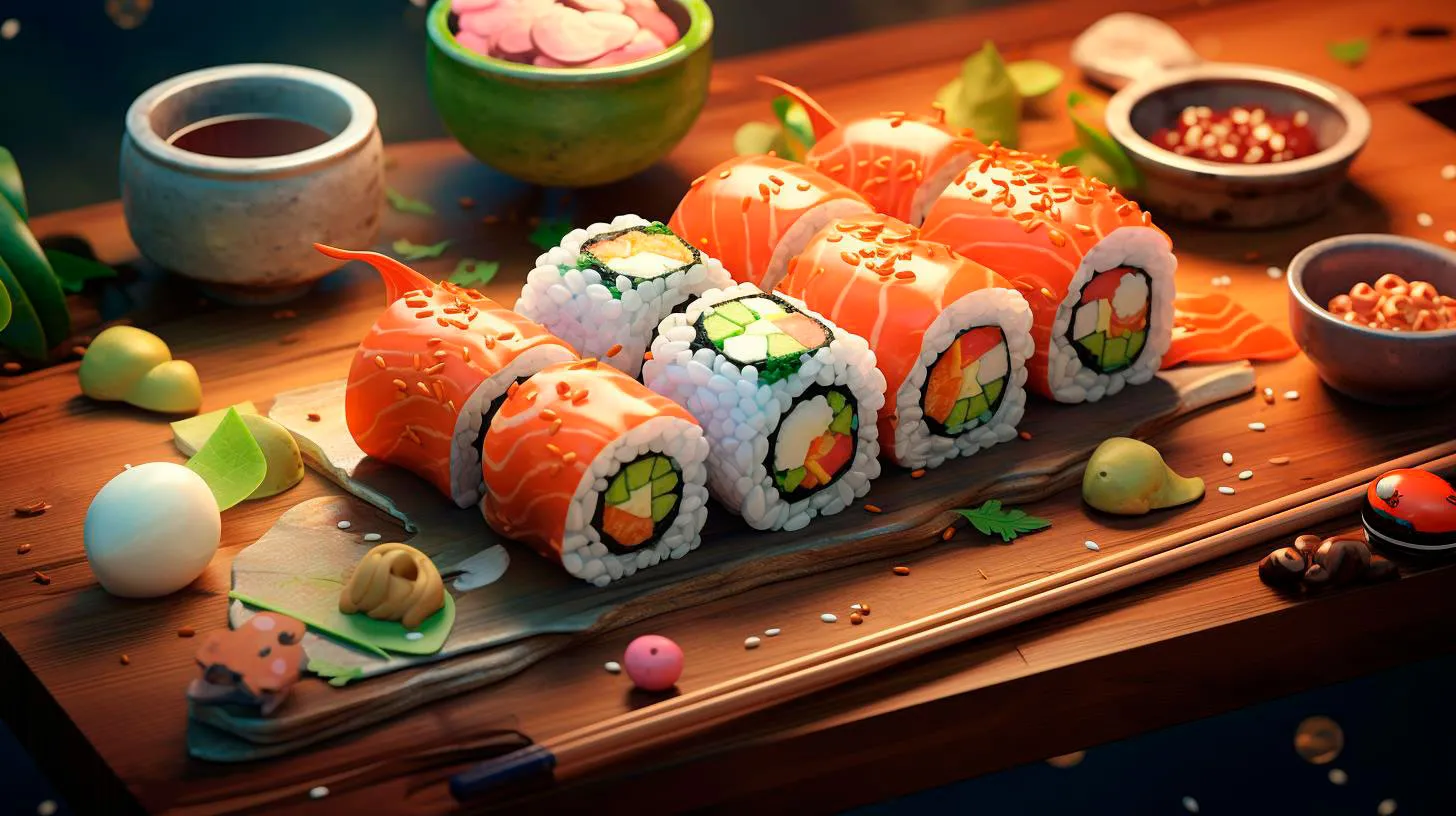From Farm to Plate: Exploring Fresh and Sustainable Sushi Ingredients
In this article, we will take you on a journey from farm to plate, exploring the world of fresh and sustainable sushi ingredients.
The Importance of Freshness in Sushi
When it comes to sushi, freshness is key. The quality and taste of your sushi largely depend on the freshness of its ingredients. From the fish to the seaweed, every component of your sushi roll needs to be of the highest quality to ensure a remarkable dining experience. Here are some reasons why freshness matters when it comes to sushi:
- Fresh ingredients enhance the flavor and texture of sushi.
- Fresh seafood reduces the risk of foodborne illnesses.
- High-quality ingredients make your sushi more aesthetically pleasing.
- Freshness is closely linked to sustainability and responsible sourcing.
The Sustainable Seafood Movement
As the demand for sushi continues to grow, so does the importance of sustainable sourcing in the seafood industry. Sustainable seafood is caught or farmed in a way that minimizes its environmental impact and ensures its availability for future generations. Here are some key aspects of the sustainable seafood movement:
- Traceability: Through advancements in technology and regulations, it is now possible to trace the journey of your seafood from the fishing boat to your plate. This level of transparency allows consumers to make informed choices and supports responsible fishing practices.
- Seasonality: Embracing seasonal seafood not only ensures its freshness but also helps to maintain healthy fish populations. By consuming seafood when it is naturally abundant, we can help prevent overfishing and the depletion of marine resources.
- Aquaculture: Sustainable aquaculture, also known as fish farming, provides an alternative to wild-caught seafood. When done responsibly, fish farming can minimize the impact on wild fish stocks, reduce habitat destruction, and alleviate pressure on threatened species.
- Certifications: Various certifications, such as the Marine Stewardship Council (MSC) and Aquaculture Stewardship Council (ASC), play a crucial role in ensuring that seafood products meet specific environmental and social criteria. Look out for these certifications when choosing sushi ingredients.
The Farm-to-Table Approach
Beyond the seafood component, sushi also incorporates other fresh and sustainable ingredients that contribute to its unique taste. Let’s explore some of these key ingredients:
1. Rice:
High-quality sushi rice is the backbone of every great sushi roll. Short-grain rice is typically used for sushi due to its stickiness and ability to hold shape. Look for sushi rice that is sustainably and locally sourced to support environmentally friendly farming practices.
2. Seaweed:
Nori, the seaweed used to wrap sushi, adds a nutty and slightly salty flavor to each bite. Opt for sustainably harvested seaweed to ensure that the marine ecosystem is not harmed during the harvesting process. Seaweed farming can also have positive environmental impacts by absorbing carbon dioxide and providing habitats for marine life.
3. Vegetables:
Sushi wouldn’t be complete without a variety of fresh vegetables. From crisp cucumber to creamy avocado, these ingredients add texture and flavor to your sushi rolls. Whenever possible, choose locally sourced, organic vegetables to support sustainable farming practices and reduce carbon emissions associated with long-distance transportation.
4. Condiments and Sauces:
Condiments like soy sauce, wasabi, and pickled ginger are essential for enhancing the taste of sushi. Look for organic and naturally brewed soy sauce, as well as sustainably sourced wasabi, to ensure the authenticity and quality of your condiments. Making your own pickled ginger using locally sourced ingredients can also be a fun and sustainable option.
Key Takeaways
Exploring fresh and sustainable sushi ingredients not only elevates your dining experience but also plays a significant role in promoting a more responsible and environmentally conscious food culture. Remember these key takeaways when choosing sushi ingredients:
- Freshness is crucial to ensuring the best taste and quality of your sushi.
- Sustainable seafood practices protect the environment and ensure seafood availability for future generations.
- Traceability and certifications help you make informed choices and support responsible fishing practices.
- Opt for locally sourced, organic ingredients whenever possible to support sustainable farming practices and reduce carbon emissions.
So, the next time you indulge in a delectable sushi roll, take a moment to appreciate the journey each ingredient has taken from farm to plate. By choosing fresh and sustainable sushi ingredients, you can savor every bite while contributing to a more sustainable and responsible food industry.
Artistic Edibles Culinary Innovations that Transform Sushi into Masterpieces
Combining meticulous craftsmanship, fresh ingredients, and innovative presentation, these culinary artists are impressing diners with their edible works of art that not only look outstanding but also taste exquisite.
Inventive Sushi Techniques and Presentation
Artistic sushi innovation encompasses a range of techniques and presentation methods that elevate the dining experience to new heights. Here are some of the remarkable techniques that have gained popularity:
- Edible Flower Art: Artistic sushi chefs are incorporating edible flowers into their creations, adding a vibrant and visually striking element to the dish. Delicate blossoms like pansies, chrysanthemums, and cherry blossoms perfectly complement the fresh fish and rice.
- Glass-Like Sushi: Using a technique called “sokusai,” sushi chefs transform fish into translucent, glass-like slices. This technique highlights the delicate texture and reduces the fishy aroma, enhancing the overall sushi experience.
- Sushi Mosaics: Sushi chefs are taking inspiration from mosaic art to create intricate patterns by arranging differently colored fish, vegetables, and rice to form visually stunning designs on the plate.
- Sushi Rolls as Canvases: By using different-colored rice, sushi chefs are turning sushi rolls into canvases for their creativity. They intricately shape the rolls to create beautiful patterns and shapes that resemble Japanese paintings or landscapes.
Advantages of Artistic Sushi Innovations
The surge in artistic sushi innovation brings several advantages to both sushi enthusiasts and the culinary industry at large:
- Visual Appeal: These artistic sushi creations are undeniably captivating, attracting food lovers from all walks of life. The vibrant colors, precise arrangements, and attention to detail make for stunning Instagram posts and memorable dining experiences.
- Enhanced Dining Experience: By expanding traditional sushi techniques, chefs provide a multi-sensory experience. Diners not only savor the flavors but also appreciate the artistry and craftsmanship behind each sushi piece, elevating the entire dining experience.
- Boost to Culinary Tourism: Artistic sushi has become a tourist attraction in itself, drawing travelers who are eager to experience these edible masterpieces. Sushi restaurants that embrace and innovate within this trend can benefit from increased footfall and revenue.
- Cultural Fusion: Artistic sushi innovations are not limited to Japan but have spread worldwide. This culinary trend serves as a bridge between cultures, combining traditional Japanese techniques with local ingredients and influences.
Key Takeaways
- Artistic sushi innovations have transformed the traditional sushi-making techniques.
- Techniques like edible flower art, glass-like sushi, sushi mosaics, and sushi rolls as canvases have gained popularity.
- Artistic sushi creations provide visual appeal, enhance the dining experience, and boost culinary tourism.
- This culinary trend promotes cultural fusion and helps bridge the gap between different cultures.
In conclusion, the rise of artistic sushi innovations has revolutionized the culinary world. Sushi is no longer just a delicious dish; it has become a form of edible art. Diners have the opportunity to witness the skill and creativity of sushi chefs while indulging in a visual and gastronomic feast. These innovative creations not only please the senses but also promote cultural fusion and culinary tourism. So, the next time you savor a well-crafted sushi masterpiece, take a moment to appreciate the artistry behind it.
Sushi Fusion: Unique Flavors Inspired by Global Cuisine
From Mexican-inspired sushi rolls to Italian-infused sashimi, sushi fusion offers a whole new level of culinary adventure. In this article, we will explore the world of sushi fusion and how it captures the essence of global cuisine.
What is Sushi Fusion?
Sushi fusion refers to the art of blending different culinary techniques, ingredients, and flavors to create unique sushi combinations. While traditional sushi mainly consists of vinegared rice, raw fish, and seaweed, sushi fusion takes it a step further by incorporating elements from other cuisines. This innovative approach to sushi has gained popularity worldwide, appealing to both sushi enthusiasts and those seeking new gastronomic experiences.
The Art of Sushi Fusion
Sushi fusion, much like any other culinary art form, requires creativity and a deep understanding of various flavor profiles. Sushi chefs experiment with different ingredients and explore diverse cooking techniques to develop their own signature fusion creations. By combining the freshest ingredients and infusing them with international flavors, sushi fusion brings forth a whole new range of taste sensations.
Flavors Inspired by Global Cuisine
One of the most exciting aspects of sushi fusion is the sheer variety of flavors inspired by global cuisine. Let’s explore some of the popular fusion flavors:
- Mexican-inspired Sushi: Infused with the vibrant and spicy flavors of Mexico, these sushi rolls often incorporate ingredients like jalapenos, avocado, and chipotle.
- Italian-inspired Sashimi: Combining the elegance of Japanese sashimi with the rich flavors of Italy, this fusion often features fresh fish paired with ingredients like truffle oil, balsamic reduction, or Parmesan cheese.
- Indian-inspired Maki: Spices and aromatic herbs common in Indian cuisine find their way into sushi fusion. Think curried rice, tandoori salmon, or paneer-stuffed rolls!
- Hawaiian-inspired Poke Bowls: Originating from Hawaii, these bowls typically consist of marinated raw fish served over a bed of rice or salad, complemented by ingredients like pineapple, mango, or macadamia nuts.
Sushi fusion offers endless possibilities for adventurous eaters, combining the delicacy of Japanese cuisine with the boldness of international flavors.
Key Takeaways
As sushi continues to evolve, it has become a canvas for chefs to showcase their creativity and gastronomic explorations. Here are some key takeaways about sushi fusion:
- Sushi fusion blends diverse culinary traditions to create unique and exciting flavor combinations.
- By infusing sushi with global flavors, chefs offer a new level of culinary adventure for sushi enthusiasts.
- Popular fusion flavors include Mexican-inspired sushi, Italian-infused sashimi, Indian-inspired maki, and Hawaiian-inspired poke bowls.
- With sushi fusion, you can experience the best of multiple cuisines in a single bite.
So, the next time you find yourself craving sushi, why not venture beyond the traditional? Explore the world of sushi fusion and indulge in a culinary adventure that transcends borders. Let your taste buds travel the globe and savor the unique flavors inspired by global cuisine.
Breaking Boundaries: Reinventing Traditional Sushi Rolls with Unexpected Ingredients
As a result, sushi rolls have become more diverse, creative, and exciting than ever before.
With the fusion of various cuisines and the incorporation of unconventional flavors, sushi rolls have transformed into a true culinary art form. The incorporation of unexpected ingredients has not only revolutionized the taste experience but has also presented endless possibilities for food enthusiasts and creative chefs alike.
Embracing Fusion
One of the most notable trends in reinventing traditional sushi rolls is the fusion of different culinary traditions. Sushi rolls are no longer limited to Japanese flavors but have successfully integrated influences from various parts of the world. This fusion approach has brought about new and exciting combinations that awaken the taste buds and tantalize the senses.
Advantages:
- Fusion sushi rolls offer a unique blend of flavors, making each bite a delightful surprise.
- It allows people from different cultures to connect and appreciate each other’s culinary heritage.
- Using unexpected ingredients sparks creativity and fosters innovation in the culinary world.
Exploring Unconventional Ingredients
Another key aspect of reinventing sushi rolls is the use of unconventional ingredients. Who would have thought that ingredients like fruits, vegetables, and even non-seafood proteins would find their way into a sushi roll?
The addition of unexpected ingredients not only brings new textures and flavors to the table but also enhances the visual appeal of sushi rolls. Vibrant colors and unique combinations make each dish a work of art that truly stands out.
Advantages:
- Unconventional ingredients add a fresh twist to classic sushi rolls, appealing to those seeking unique dining experiences.
- They provide options for vegetarian, vegan, and gluten-free sushi rolls, catering to a broader range of dietary needs.
- Experimenting with different ingredients allows chefs to showcase their creativity and artistic flair.
Key Takeaways
Reinventing traditional sushi rolls with unexpected ingredients has transformed the culinary landscape. The fusion of cuisines and incorporation of unconventional flavors have breathed new life into this beloved Japanese dish.
By embracing fusion, sushi rolls are no longer confined to traditional Japanese recipes and offer a global experience on every plate. Exploring unconventional ingredients has led to surprising and delightful combinations, ensuring that each sushi roll is a unique and memorable experience.
So next time you have sushi, let go of traditional expectations and open yourself up to the world of reinvented sushi rolls. You might just discover a new favorite flavor or combination that transcends boundaries and leaves you craving for more.
Remember, sushi is no longer just a dish—it’s a journey of flavors, textures, and endless possibilities.


